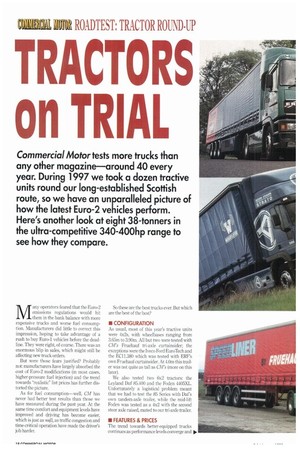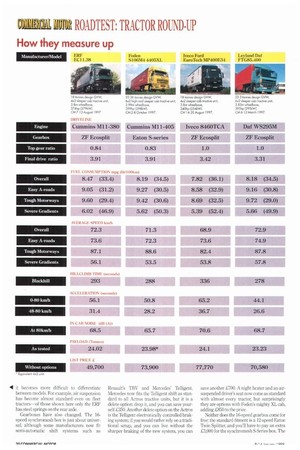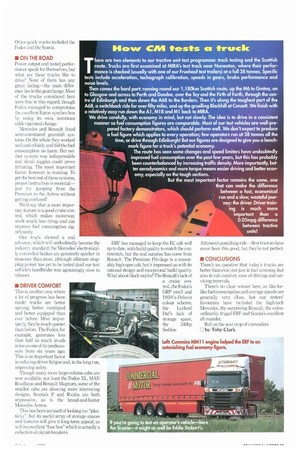MEIII1JJ1 ROADTEST: TRACTOR ROUND-UP
Page 20

Page 22

Page 23

Page 24

Page 25

If you've noticed an error in this article please click here to report it so we can fix it.
TRACTORS on TRIAL
Commercial Motor tests more trucks than any other magazine—around 40 every year. During 1997 we took a dozen tractive units round our long-established Scottish route, so we have an unparalleled picture of how the latest Euro-2 vehicles perform. Here's another look at eight 38-tonners in the ultra-competitive 340-400hp range to see how they compare.
Many operators feared that the Euro-2 emissions regulations would hit them in the bank balance with more expensive trucks and worse fuel consurnption. Manufacturers did little to correct this impression, hoping to take advantage of a rush to buy Euro-1 vehicles before the deadline. They were right, of course. There was an enormous blip in sales, which might still be affecting new truck orders.
But were those fears justified? Probably not manufacturers have largely absorbed the cost of Euro-2 modifications (in most cases. higher-pressure fuel injection) and the trend towards "realistic" list prices has further distorted the picture.
As for fuel consumption—well, CM has never had better test results than those we have measured during the past year. At the same time comfort and equipment levels have improved and driving has become easier, which is just as well, as traffic congestion and time-critical operation have made the driver's job harder. So these are the best trucks ever. But which are the best of the best?
• CONFIGURATION As usual, most of this year's tractive units were 4x2s, with wheelbases ranging from 3.65m to 3.90m. All but two were tested with CM's Fruehauf tri-axle curtainsider; the exceptions were the lveco Ford FuroTech and the EC11.380 which was tested with ERF's own Fruehauf curtainsider. At 4.0m this trailer was not quite as tall as GM's (more on this later).
We also tested tyr.o 6x2 tractors: the Leyland Daf 85.400 and the Foden 4405XL. Unfortunately a logistical problem meant that we had to test the 85 Series with Daf's own tandem-axle trailer, while the mid-lift Foden was tested as a 4x2 with the second steer axle raised, mated to our tri-axle trailer.
• FEATURES & PRICES The trend towards better-equipped trucks continues as performance levels converge and • it becomes more difficult to differentiate between models. For example, air suspension has become almost standard even on fleet tractors-of those shown here only the ERF has steel springs on the rear axle.
Gearboxes have also changed. The 16speed synchromesh box is just about universal, although some manufacturers now fit semi-automatic shift systems such as Renault's TBV and Mercedes' Telligent. Mercedes now fits the Telligent shift as standard to all Actros tractive units, but it is a delete option: drop it, and you can save yourself .E350. Another delete option on the Actros is the Telligent electronically controlled braking system; if you would rather rely on a traditional setup, and you can live without the sharper braking of the new system, you can
save another £700. A night heater and an airsuspended driver's seat now come as standard with almost every u-actor, but surprisingly they are options with Foden's mighty XL cab, adding £850 to the price.
Neither does the 16-speed gearbox come for free: the standard fitment is a 12-speed Eaton Twin Splitter, and you'll have to pay an extra £3,000 for the synchromesh S-Series box. The Focle.n truly is a made-to-measure truck.
It's never been easy to judge the true price of a truck because so much depends on the customer, the method of payment and the manufacturer's situation at the time. The introduction of "realistic" pricing by several manufacturers, following Volvo's lead, has not helped at all. Now list prices make less sense than ever, and the apparent spread between the cheapest (ERF) and most expensive (Iveco Ford) tractor in our selection is more than 428,000! Somehow, we doubt whether this would apply in practice.
• PAYLOAD At least payload is more straightforward, and easier to compare than price. Here the spread is relatively small with just 310kg separating the best 4x2 unit from the worst, All our figures are as tested, assuming the full 38-tonne gross weight, a 7,000kg trailer, a full tank of fuel and a 75kg driver.
Incidentally, nearly every one of these tractors was running on alloy wheels, and one or two had non-standard fuel tanks. Most outrageous was the Mercedes, which made do with a tiny 250-litre rank: the standard 400-litre job lo would have knocked its payload back by around 130kg. Conversely, the Iveco's 24.10tonne payload is all the more creditable for its 600-litre tank.
• FUEL CONSUMPTION This is the most contentious of figures, and our method of testing cannot tell exactly what sort of economy an operator should get—but it can still give a reliable guide to how different trucks compare.
Just a couple of years ago any truck which bettered 8mpg round our Scottish route was exceptional; now it has become the norm, and we are expecting to see a truck beat 8.5mpg before long. These are not insignificant changes. Even a 5% improvement in fuel consumption represents several thousand pounds a year to most operators.
One truck has come very close to 8.5mpg; ERF's EC11.38ST managed 8.47mpg, albeit with ERF 's own 4,0m-high trailer rather than our 4.2m Fruehauf. This was one of the Sandbach firm's "Fuel Duel" demonstration vehicles, lovingly prepared by ERF test ace Derek Rafferty, Following its extraordinary performance we gave it a thorough check: oil analysis showed nothing unusual, and the only slight discrepancy was over-inflation of the (well-worn) tyres.
Among the fleet tractors we tested with our own trailer the best result came from Mercedes' Actros 18351S, which delivered 8.26mpg. This is an excellent figure, though Foden, Leyland Oaf, Scania and Seddon Atkinson are all snapping at its heels.
One noticeable trend has been the excellent performance of Cummins' all-electronic Ml 1 engine, which has given good results in ERF, Foden and Seddon Atkinson applications. The Foden might well have delivered slightly better fuel returns as a 6x2 with the second steer axle cutting rolling resistance, but we had to test it as a 4x2,
Another trend is the drift towards higher power, with 380-400hp becoming typical for a 38-tonne fleet tractor, which delivers noticeably better average speeds than a 340hp unit with no loss of fuel economy. Quite the reverse, in fact; with modern injection systems a powerful engine need not work inefficiently at light loads.
The best fuel figure ever obtained by a Euro-2 truck with CM's tri-axle trailer is not shown here. The figure was 8.28mpg overall and the tractor was Leyland Dal's 95XF 489, which is a top-flight artic in every sense. This is a remarkable achievement, especially from a non-electronic engine.
• SPEEDS These days, average speeds are all too often dictated by traffic conditions and speed-limiter settings, and performance is shown best in the most difficult conditions, such as the speed over our "severe gradients" section. Our 0-80km/h and hill-climb times are useful too: you can see that the 400hp trucks have a fair edge over the 350hp contenders, although gearing is critical.
A good choice of gears (and perfectly still air conditions) allowed the Leyland Daf to record an exceptionally fast 0-80krn/h time.
Other quick trucks included the Foden and the Scania.
• ON THE ROAD
Power output and tested performance speak for themselves, but what are these trucks like to drive? None of them has any great failing—the main difference lies in the gearchange. Most of the trucks considered here were fine in this regard, though Foden managed to compromise the excellent Eaton synchro box by using its own, notorious cable-operated change.
Mercedes and Renault fitted semi-automated gearshift systems. On the whole they worked well and reliably and did the fuel consumption no harm. But neither system was indispensable and detail niggles could prove irritating. The most important factor, however, is training. To get the best out of these systems, proper instruction is essential— just try jumping from the Premium to the Actros without getting confused!
We'd say that a more important feature is a good cruise control, which makes motorway work much less tiring and can improve fuel consumption significantly.
One truck showed a real advance, which will undoubtedly become the industry standard: the Mercedes' electronically controlled brakes are genuinely quicker in response than most, although ultimate stopping power has yet to be tested (and our test vehicle's handbrake was agonisingly slow to release).
• DRIVER COMFORT This is another area where a lot of progress has been made: trucks are better sprung, better ventilated and better equipped than ever before. Most importantly, they're much quieter than before. The Foden, for example, generates less than half as much in-cab noise as one of its predecessors from six years ago. This is an important factor
in reducing driver fatigue and, in the long run, improving safety.
Though many more large-volume cabs are now available, not least the Foden XL, MAN Roadhaus and Renault Magnum, some of the smaller cabs are showing more interesting designs. Scania's P and R-cabs are both impressive, as is the bread-and-butter Mercedes Actros.
This has been accused of looking too "plasticky”, but its useful array of storage spaces and features will give it long-term appeal, as will its excellent "fuse box" which is actually a collection of circuit-breakers.
ERF has managed to keep the EC cab well up to date, with build quality to match the continentals, but the real surprise has come from Renault, The Premium Privilege is a reasonably high-spec cab, but it impressed us with its rational design and exceptional build quality. What about black marks? The Renault's lack of a cruise control...the Foden's GRP smell and 1950's-Odeon colour scheme, the Leyland Dat's lack of storage space,
the 340hp Seddon Atkinson's punishing ride—fleet tractors have never been this good, but they're not perfect.
• CONCLUSIONS
There's no question that today's trucks are better than ever; not just in fuel economy, but also in cab comfort, ease of driving and servicing intervals.
There's no clear winner here, as like-forlike fuel consumption and average speeds are generally very close, but our testers' favourites have included the high-tech Mercedes, the surprising Renault, the extraordinarily frugal ERF and Scania's excellent all-rounder.
Roll on the next crop of contenders.
Fi by Toby Clark
How CAI tests a truck
There are two elements to our tractive unit test programme: track testing and the Scottish route. Trucks are first examined at MIRA's test track near Nuneaton, where their performance is checked (usually with one of our Fruehauf test trailers) at a full 38 tonnes. Specific tests include acceleration, tachograph calibration, speeds in gears, brake performance and noise levels.
Then comes the hard part: running round our 1,180km Scottish route, up the M6 to Gretna, on to Glasgow and across to Perth and Dundee, over the Tay and the Firth of Forth, through the centre of Edinburgh and then down the A68 to the Borders. Then it's along the toughest part of the A68, a switchback ride for over fifty miles, and up the gruelling Blackhill at Consett. We finish with a relatively easy run down the Al, M18 and M1 back to MIRA.
We drive carefully, with economy in mind, but not slowly. The idea is to drive in a consistent manner so fuel consumption figures are comparable. Most of our test vehicles are well-prepared factory demonstrators, which should perform well. We don't expect to produce a fuel figure which applies to every operation; few operators run at 38 tonnes all the time, or drive through Edinburgh! But our figures are designed to give you a benchmark figure for a truck's potential economy.
The route has seen some changes and speed limiters have undoubtedly improved fuel consumption over the past few years, but this has probably been counterbalanced by increasing traffic density. More importantly, better aerodynamics and more torque means easier driving and better economy, especially on the tough sections.
But the most important factor remains the same, one that can make the difference between a fast, economical run and a slow, wasteful journey: the driver. Driver training is much more important than a 0.05mpg difference between tractive units!
































































































